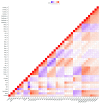Importance of Meteorological Parameters and Airborne Conidia to Predict Risk of Alternaria on a Potato Crop Ambient Using Machine Learning Algorithms
- PMID: 36146412
- PMCID: PMC9500921
- DOI: 10.3390/s22187063
Importance of Meteorological Parameters and Airborne Conidia to Predict Risk of Alternaria on a Potato Crop Ambient Using Machine Learning Algorithms
Abstract
Secondary infections of early blight during potato crop season are conditioned by aerial inoculum. However, although aerobiological studies have focused on understanding the key factors that influence the spore concentration in the air, less work has been carried out to predict when critical concentrations of conidia occur. Therefore, the goals of this study were to understand the key weather variables that affect the hourly and daily conidia dispersal of Alternaria solani and A. alternata in a potato field, and to use these weather factors in different machine learning (ML) algorithms to predict the daily conidia levels. This study showed that conidia per hour in a day is influenced by the weather conditions that characterize the hour, but not the hour of the day. Specifically, the relative humidity and solar radiation were the most relevant weather parameters influencing the conidia concentration in the air and both in a linear model explained 98% of the variation of this concentration per hour. Moreover, the dew point temperature three days before was the weather variable with the strongest effect on conidia per day. An improved prediction of Alternaria conidia level was achieved via ML algorithms when the conidia of previous days is considered in the analysis. Among the ML algorithms applied, the CART model with an accuracy of 86% were the best to predict daily conidia level.
Keywords: Alternaria spp.; Solanum tuberosum; aerobiology; decision trees; early blight; k-nearest neighbor; machine learning; random forest; weather factors.
Conflict of interest statement
The authors declare that they have no conflict of interest.
Figures









Similar articles
-
Effects of meteorological factors on the levels of Alternaria spores on a potato crop.Int J Biometeorol. 2011 Mar;55(2):243-52. doi: 10.1007/s00484-010-0330-4. Epub 2010 Jun 13. Int J Biometeorol. 2011. PMID: 20549521
-
Comparative study of airborne Alternaria conidia levels in two cities in Castilla-La Mancha (central Spain), and correlations with weather-related variables.Ann Agric Environ Med. 2012;19(2):227-32. Ann Agric Environ Med. 2012. PMID: 22742792
-
Aerial Concentrations of Pathogens Causing Early Blight and Brown Spot Within Susceptible Potato Fields.Phytopathology. 2019 Aug;109(8):1425-1432. doi: 10.1094/PHYTO-10-18-0381-R. Epub 2019 Jul 1. Phytopathology. 2019. PMID: 30995159
-
Airborne fungal spores of Alternaria, meteorological parameters and predicting variables.Int J Biometeorol. 2015 Mar;59(3):339-46. doi: 10.1007/s00484-014-0845-1. Epub 2014 May 21. Int J Biometeorol. 2015. PMID: 24844880
-
Aerobiological modeling I: A review of predictive models.Sci Total Environ. 2021 Nov 15;795:148783. doi: 10.1016/j.scitotenv.2021.148783. Epub 2021 Jul 2. Sci Total Environ. 2021. PMID: 34243002 Review.
Cited by
-
Predicting Daily Aerobiological Risk Level of Potato Late Blight Using C5.0 and Random Forest Algorithms under Field Conditions.Sensors (Basel). 2023 Apr 8;23(8):3818. doi: 10.3390/s23083818. Sensors (Basel). 2023. PMID: 37112159 Free PMC article.
References
-
- Abuley I.K., Nielsen B.J. Evaluation of models to control potato early blight (Alternaria solani) in Denmark. Crop Prot. 2017;102:118–128. doi: 10.1016/j.cropro.2017.08.012. - DOI
-
- Meno L., Escuredo O., Rodríguez-Flores M.S., Seijo M.C. Looking for a sustainable potato crop. Field assessment of early blight management. Agric. For. Meteorol. 2021;308:108617. doi: 10.1016/j.agrformet.2021.108617. - DOI
-
- Abuley I.K., Nielsen B.J. Integrating cultivar resistance into the TOMCAST model to control early blight of potato, caused by Alternaria solani. Crop Prot. 2019;117:69–76. doi: 10.1016/j.cropro.2018.11.007. - DOI
-
- Meno L., Escuredo O., Rodríguez-Flores M.S., Seijo M.C. Modification of the tomcast model with aerobiological data for management of potato early blight. Agronomy. 2020;10:1872. doi: 10.3390/agronomy10121872. - DOI
-
- Cowgill W.P., Maletta M.H., Manning T., Tietjen W.H., Johnston S.A., Nitzsche P.J. Early blight forecasting systems: Evaluation, modification, and validation for use in fresh-market tomato production in northern New Jersey. HortScience. 2005;40:85–93. doi: 10.21273/HORTSCI.40.1.85. - DOI
MeSH terms
Grants and funding
LinkOut - more resources
Full Text Sources
Miscellaneous

